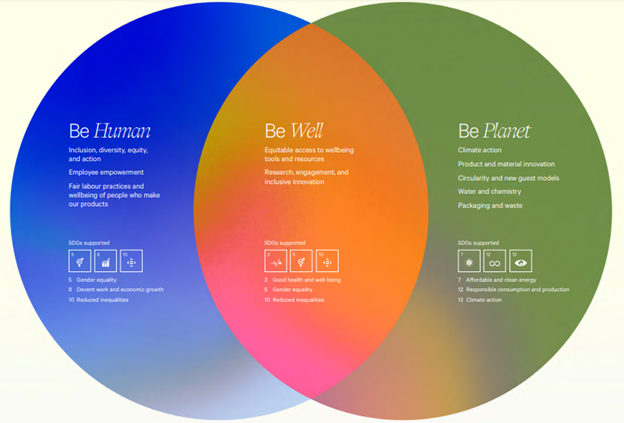Climate change has us all sweating (and not just in yoga pants). It’s made individuals, businesses, and governments rethink their actions. How does lululemon stack up in the grand scheme of environmental impact?
Let’s face it, sustainability is trendy AF right now. And every brand wants to cash in on that sweet, sweet eco-conscious consumer dollar. But how much of it is a genuine effort, and how much is just clever greenwashing?
lululemon athletica is big—like, colossal. We’re talking 38,000 employees and 711 stores. So, the stakes are high considering the brand’s global presence and the extensive nature of lululemon’s supply chain.
The question on everyone’s lips?

Right now, in 2024, Lululemon isn’t 100% sustainable. Shocker.
But hold your gasps—they aim to be by 2030, based on their three-headed impact agenda: be human, be well, and be the planet.
In the 2023 Fashion Transparency Index, lululemon scored an overall 51% based on the index ranking in 5 main areas which include:
Each year, the spotlight issues vary and for this year, the spotlight issues include six areas which are:
According to the index, brands scoring between 51-60% are:

So, lululemon is like that kid in class who’s just getting above average but isn’t in nerd territory yet. They have made some big promises. Like, REALLY big; through their “Impact Agenda.”
Think of reducing their environmental footprint, using more sustainable materials, and becoming a fully circular brand. All by 2030. Ambitious? Totally. Achievable? We’ll see.
lululemon’s sustainability strategy involves three main approaches: using less water, innovating more sustainable materials, and encouraging product reuse.
Let’s analyze lululemon’s sustainability from these 3 perspectives.
The fashion industry is a thirsty beast. Like, seriously thirsty. It’s one of the biggest water guzzlers out there. lululemon knows this and they’re all about shrinking their water footprint. Why? Because drying up our springs and groundwater isn’t a cute look.
The company intends to reduce water usage by innovating more water-efficient processes in its product manufacturing.
For example, the brand’s innovation of a solution-dye process for application in more complex nylon products reduces the amount of water used in dye application.
lululemon states that it is committed to reducing the average freshwater usage with its priority wet process suppliers in its product manufacturing process by 20% by 2025.
Ambitious? Yes. Doable? We’ll see.

lululemon’s aiming for 100% sustainable materials by 2030. Think recycled, regenerative, responsibly sourced, or renewable fibers. They would also be manufactured using processes that have a lower impact on natural resources. Sounds fancy, right?
The brand specifies that:
We assess material production and product impacts using multiple sources including the Higg Materials Sustainability Index69 (Higg MSI) and Product Module70 (PM), as well as select lifecycle assessment (LCA) methodologies. We also partner with our suppliers to conduct LCAs on products and materials.
Partnerships with companies like Bolt Threads, Geno, and LanzaTech help them create revolutionary fabrics that they incorporate into lulu’s product lines. But, as is typical of a company that likes outdoing itself, lululemon has gone further, intending to achieve commercial scaling of the materials that will result from these collaborations.
The brand has made significant progress in embedding sustainability into the following materials:
lululemon uses natural rubber and regenerated cellulosic materials such as rayon, viscose, lyocell, and modal in some of its products.
Since 2018, almost 100% of the regenerated cellulosic fibers used in the brand’s products have been sourced responsibly. The brand uses CanopyStyle Audits to verify that its producers are at low risk of sourcing from controversial sources, ancient, or endangered forests.
When lululemon set up its impact agenda in 2020, it had a plan to have 100% of its forest-based materials third-party audited or certified by 2023 but hey, they are ahead of the curve, they hit it in 2022.
A case in point is the use of Forest Stewardship Council (FSC)-certified natural rubber in the brand’s yoga mats. They have also launched products using a fabric blend made up of up to 30% recycled cellulose from waste cotton instead of virgin wood feedstock. The fabric is known as REFIBRA and is made by the Lenzing Group. Bye-bye, virgin wood feedstock.
Cotton was the third-largest material used in lululemon products in 2022 and to achieve sustainability in this aspect, the company has been committed to sourcing it from suppliers who have been certified or identified with sustainable cotton platforms.
lululemon has partnered with stakeholders in the cotton farming, processing, and manufacturing industries in several ways. One such way is by supporting markets and suppliers that are certified to produce organic, regenerative, or recycled cotton.
The company also supports farmers in improving farming practices, taking into cognizance the amount of water used, field-specific soil conditions, nutrients, and other factors that may affect the cultivation of cotton. This is aimed at maintaining and restoring local environments while increasing the cotton yield.
By adopting these practices, lululemon hopes to improve its existing cotton supply chain while minimizing the environmental impact of cotton cultivation and processing. The brand also aims to ensure greater visibility into social and animal welfare as a direct or indirect result of cotton farming.
And what’s the timeline for achieving all these? 2025. Wish them luck!
The largest procured fiber by lululemon is polyester. It comprised 34% of the fibers bought by the brand in 2022; this represents 12,138kg of polyester. Intending to hit the sustainability goal of 75% recycled polyester by 2025, they’re at 55% now.
lululemon is chalking up major points for using post-consumer recycled content such as plastic bottles. Plastic bottles turned into yoga pants? We love to see it.
By ensuring that a large percentage of its suppliers make polyester from used plastics instead of fossil fuels, the brand has reduced energy use in its polyester production supply chain by up to 45% and carbon dioxide emissions by 30%.
lululemon is actively participating in initiatives such as the 2025 Recycled Polyester
Challenge which is aimed at increasing the global recycled polyester uptake
from 14% to 45% by 2025.
Nylon is made up of 33% of the materials used by lululemon. It is an essential material that provides the brand’s apparel with certain characteristic features such as being soft to the touch, sweat-wicking, high tenacity, and abrasion resistance.
Nylon is essential to the lululemon products we know and love, but, reaching sustainability in this aspect is almost a nightmare for the brand. By 2030, they want to switch 100% to recycled, renewable nylon, or newly innovated nylon fibers but they are currently at just 8%. Whew! they’ve got a hill to climb.
To make the climb a little easier, the brand is committed to launching alternative platforms by 2025 to help meet its target.
For instance, in April 2023, Lululemon launched a pilot of Swiftly and Metal Vent Tech Short Sleeve Shirts which are composed of plant-based nylon. They are also exploring the option of recycled nylon made from post-industrial material waste.
lululemon also launched a plant-based nylon 6 which focuses on a bio-based solution for the precursor to nylon 6, caprolactam. They are also working toward solutions for the building blocks for nylon 6,6, which will focus on bio-based or recycled sources for adipic acid and
hexamethylenediamine (HMD).
These are some of the ways lululemon has collaborated with industry experts to innovate, create, develop, and produce sustainable nylon fibers that meet their performance requirements while ensuring scalability in the long term.
Wool, silk, down, and cashmere make up a tiny 1% by weight of the materials lululemon uses in its apparel. They’re aiming for 100% responsible sourcing by 2025. So far, they’ve hit 75%.
lululemon hopes to achieve sustainability here by ensuring that they trace or certify as sourced responsibly all their animal-derived materials. They are equally committed to upholding strong animal welfare practices throughout their supply chain. They are also working on innovative alternatives to some animal-derived materials.
The brand’s collaboration with mycelium-based leather manufacturer, Bolt Threads in using Mylo as a replacement for animal leather is a commendable step in the right direction; aiding lululemon to maintain its status as an animal-based leather-free company.
Remember that whole “circular brand” goal? Yeah, that’s a big one. The idea is to create a closed-loop system where clothes are designed to be recycled or repurposed, reducing waste and keeping products out of landfills.
Curious about how they are focusing on circularity? Here goes:
lululemon likes to stand out in the crowded athleisure market by not only being an eco-friendly clothing brand but by also uniquely referring to their customers as guests. They launched the Like New initiative in May 2021 so that instead of dumping your gently used clothes, you can resell them to others who need them.
This initiative has recorded tremendous success in reducing the amount of clothes that would have ended up in landfills. We are talking a whooping 1.7 million clothes reduction. The profits generated through this initiative are reinvested into sustainability initiatives.
In 2022 and 2023, Like New profits were used to support the Apparel Impact Institute’s Fashion Climate Fund. The fund aims to implement and advance projects that reduce carbon emissions by 2030.
lulemon has engaged its designers to bring circularity to life through training tools and innovation labs aimed at providing design solutions that consider the product’s impacts throughout its life cycle.
When designing products they consider multiple key decision points that impact carbon footprint and lifecycle, including material choice, manufacturing processes, intended product use, and disposal. They also consider the reduction of waste, extending product life cycle, and enabling end-of-life solutions toward more circular ecosystems.
Lululemon resells, donates, or recycles over 90 percent of its damaged and excess products such as returns, in-store damages, and quality issues. They partner with Medshare to donate masks and Good360 to donate clothing and support people in need. These organizations distribute the brand’s products to a network of diverse non-profits.
The main recycling partner of lululemon is Debrand. They sort, grade, and prepare lulu products for recycling. They do this through their network of reuse and recycling partners. Some of the products obtained through the recycling efforts include insulation and stuffing for mattresses, furniture, cars, and sporting equipment.
Damaged and excess footwear is recycled into stable comfort pillows and blow-in insulation. Damaged yoga mats are recycled into an equestrian footing product. Any product that cannot be recycled or reused is processed in a waste-to-energy facility.
lululemon further adapts infrastructure to take back products after first use and recycle materials into a valuable next life, including fiber-to-fiber.
It’s not all sunshine and rainbows. lululemon faces hurdles in sourcing raw materials, adopting renewable energy, and recycling.
In 2022, only 19% of their cotton was sustainably sourced, way below their 2025 goal of 100%. Yikes. Their supply chain is another beast. Only 2% of their suppliers use renewable energy. Yup, you heard that right. While lululemon boasts 100% renewable energy use in their owned and operated facilities, the broader supply chain isn’t exactly green.
Environmental protection advocates have called on the brand to support its suppliers and product manufacturers to also move away from using fossil fuels and adopt renewable energy options.
Finding recyclers that can convert finished products back into yarn is another sustainability concern for lululemon. Although technical solutions for textile recycling are highly limited to cotton and polyester,lululemon has partnered with Debrand to pilot textile-to-textile recycling technologies with their vetted partners and broader recycling infrastructure solutions.
The time taken to develop sustainable material for the brand’s diverse array of products is another challenge towards achieving sustainability. They’re piloting new tech, but scalable solutions are still a distant dream. Innovation in sustainable materials is a marathon, not a sprint. They’ve had wins like the creation of recycled polyester made from plastic bottles, carbon emissions, and even enzymatic recycling through itSs partnerships with forward-thinking companies like LanzaTech and Samsara Eco, but, they still have miles to go.
lululemon has also made improvements in areas such as low-water dye inputs, low-water garment dye washes, and recycled dye inputs.
It is therefore safe to say that although lululemon is facing several sustainability issues, the brand has made considerable investments and engaged in partnerships specifically aimed at meeting its 2030 sustainability goals.
So, back to the million-dollar question: Is lululemon sustainable? The answer, like most things in life, is complicated. They’re making some efforts, we’ll give them that. But they’ve also got a long way to go. They’re still heavily reliant on virgin materials, their supply chain isn’t fully transparent, and they’ve been accused of greenwashing.
lululemon is currently sitting pretty at 51% sustainability, aiming for 100% by 2030. They’ve got partnerships, suppliers, and recycling programs working overtime. They might just pull it off.
By holding their partners to ethical guidelines, lululemon pushes for a sustainable supply chain. The company engages in various organizations and partnerships advocating for sustainable development, aiming to reduce environmental impact, such as carbon emissions, water consumption, and promoting circular economy initiatives. They are also adopting practices and creating solutions that enhance the brand’s products, minimize negative impact, and contribute to restoring the environment.
With all these laudable steps, lululemon’s story should inspire you to also pursue sustainability in your business operation one day at a time.

Email subscription is available ONLY TODAY (oh, okay, and tomorrow).
Surely, we respect your inbox! Unsubscription works every day.

We’d love to tailor your experience — which of these best describes you?